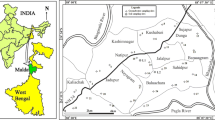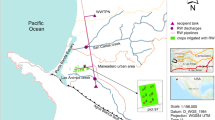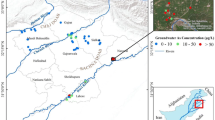Abstract
Reclaimed water is an important water resource for agricultural irrigation. Based on the systematic analysis of experimental data, this paper studies the spatiotemporal transformation and distribution of As in soil–crop system. Through the comparison with groundwater irrigation, reclaimed water irrigation was tested and studied in connection with the greenhouse vegetables in the growing season. The accumulation, distribution and transportation of As in different depths of soil within 7 days after reclaimed water irrigation were analyzed and discussed. The results showed that the concentration of As was the highest on the first day after irrigation; it was the highest at the depth of 100 cm on the third day after irrigation, but its concentration in the topsoil slightly decreased; from the fifth to the seventh day, the concentrations of As in the different layers of soil were almost the same, but it was the highest at the depth of 80–120 cm; and it decreased slightly with the increase in depth when the depth was less than 120 cm. As in soil during the growing season varied as the frequency of irrigation increased. The specific situation was as follows: as the accumulated As in the topsoil increased, the increased As at the depth of 80–120 cm would become less and the concentration of As at 200 cm would fall. Therefore, when the appropriate concentration of reclaimed water is used for irrigation, the concentration of As in the deep layer soil will comply with the standard limits of GB15618-1995 and the irrigation with reclaimed water of appropriate concentration will not cause As pollution.



Similar content being viewed by others
References
Alexakis, D., & Gamvroula, D. (2014). Arsenic, chromium, and other potentially toxic elements in the rocks and sediments of Oropos-Kalamos basin, Attica, Greece. Applied and Environmental Soil Science, 2014(718534).
Alexakis, D., Gotsis, D., & Giakoumakis, S. (2012). Assessment of drainage water quality in pre- and post-irrigation seasons for supplemental irrigation use. Environmental Monitoring and Assessment,184(8), 76–84.
Babel, S., & Kurniawan, T. A. (2003). Low-cost adsorbents for heavy metals uptake from contaminated water: a review. Journal of Hazardous Materials,97(1–3), 219–243.
Chang, J. X., Li, Y. Y., Yuan, M., & Wang, Y. M. (2017). Efficiency evaluation of hydropower station operation: A case study of Longyangxia station in the Yellow River, China. Energy,135, 23–31.
Dolnicar, S., & Schäfer, A. I. (2009). Desalinated versus recycled water: Public perceptions and profiles of the accepters. Journal of Environmental Management,90(2), 888–900.
Duan, L. Q., Song, J. M., Yuan, H. M., Li, X. G., & Li, N. (2013). Spatio-temporal distribution and environmental risk of arsenic in sediments of the east China sea. Chemical Geology,340(2), 21–31.
Fujimori, T., & Takigami, H. (2014). Pollution distribution of heavy metals in surface soil at an informal electronic-waste recycling site. Environmental Geochemistry and Health,36(1), 159–168.
Guo, Y., Huang, S. Z., Huang, Q., Wang, H., Fang, W., Yang, Y. Y., et al. (2019). Assessing socioeconomic drought based on an improved multivariate standardized reliability and resilience index. Journal of Hydrology,568, 904–918.
Henderson, R. K., Baker, A., Murphy, K. R., Hambly, A., Stuetz, R. M., & Khan, S. J. (2009). Fluorescence as a potential monitoring tool for recycled water systems: A review. Water Research,43(4), 863–881.
Jianxia, C., Xiaoyu, W., Yunyun, L., Yimin, W., & Hongxue, Z. (2018). Hydropower plant operation rules optimization response to climate change. Energy,160, 886–897.
Kumar, P., Kumar, M., Ramanathan, A. L., & Tsujimura, M. (2010). Tracing the factors responsible for arsenic enrichment in groundwater of the middle gangetic plain, India: A source identification perspective. Environmental Geochemistry and Health,32(2), 129.
Lu, S. B., & Pei, L. (2016). A study of zinc borne waste water treatment with dispersion supported liquid membrane. International Journal of Hydrogen Energy,41(35), 15717–15723.
Lu, S. B., Pei, L., & Bai, X. (2015). Study on method of domestic wastewater treatment through new-type multi-layer artificial wetland. International Journal of Hydrogen Energy,40(34), 11207–11214.
Lu, S. B., Shang, Y. Z., Pei, L., Li, W., & Wu, X. H. (2017). The effects of rural domestic sewage reclaimed water drip irrigation on characteristics of rhizosphere soil. Applied Ecology and Environmental Research,15(4), 1145–1155.
Lu, S. B., Wang, J. H., & Pei, L. (2016a). Study on the effects of irrigation with reclaimed water on the content and distribution of heavy metals in soil. International Journal of Environmental Research & Public Health,13(3), 298.
Lu, S. B., Zhang, X. L., & Bao, H. J. (2016b). Review of social water cycle research in a changing environment. Renewable and Sustainable Energy Reviews,63, 132–140.
Lu, S. B., Zhang, X. L., & Pei, L. (2016c). Influence of drip irrigation by reclaimed water on the dynamic change of the nitrogen element in soil and tomato yield and quality. Journal of Cleaner Production,139(15), 561–566.
Lu, S. B., Zhang, X. L., & Wang, J. H. (2016d). Impacts of different media on constructed wetlands for rural household sewage treatment. Journal of Cleaner Production,127, 325–330.
Meng, E. H., Huang, S. Z., Huang, Q., Fang, W., Wu, L. Z., & Wang, L. (2019). A robust method for non-stationary streamflow prediction based on improved EMD-SVM model. Journal of Hydrology,568, 462–478.
Nasir, F. A., & Batarseh, M. I. (2008). Agricultural reuse of reclaimed water and uptake of organic compounds: Pilot study at Mutah university wastewater treatment plant, Jordan. Chemosphere,72(8), 1203–1214.
Nickel, S., Hertel, A., Pesch, R., Schröder, W., Steinnes, E., & Uggerud, H. T. (2014). Modelling and mapping spatio-temporal trends of heavy metal accumulation in moss and natural surface soil monitored 1990–2010 throughout Norway by multivariate generalized linear models and geostatistics. Atmospheric Environment,99, 85–93.
Rattan, R. K., Datta, S. P., Chhonkar, P. K., Suribabu, K., & Singh, A. K. (2005). Long-term impact of irrigation with sewage effluents on heavy metal content in soils, crops and groundwater–A case study. Agriculture, Ecosystems & Environment,109(3), 310–322.
Smrkolj, P., & Stibilj, V. (2004). Determination of selenium in vegetables by hydride generation atomic fluorescence spectrometry. Analytica Chimica Acta,512(1), 11–17.
Troldborg, M., Duckett, D., Allan, R., Hastings, E., & Hough, R. L. (2017). A risk-based approach for developing standards for irrigation with reclaimed water. Water Research,126, 372.
Venegas, A., Rigol, A., & Vidal, M. (2015). Viability of organic wastes and biochars as amendments for the remediation of heavy metal-contaminated soils. Chemosphere,119, 190–198.
Weber, S., Khan, S., & Hollender, J. (2006). Human risk assessment of organic contaminants in reclaimed wastewater used for irrigation. Desalination,187(1), 53–64.
Wei, Y. H., Xu, Y. M., Zhou, Q. W., Qin, X., Sun, Y., & Dai, X. H. (2008). Effects of Irrigation with reclaimed water on soil salinize-alkalization and heavy metal distribution. Journal of Irrigation and Drainage,27(3), 5–8.
Xu, M., Bai, X., Pei, L., & Pan, H. (2016). A research on application of water treatment technology for reclaimed water irrigation. International Journal of Hydrogen Energy,41(35), 15930–15937.
Yuan, H. Z., Shen, J., Liu, E. F., Wang, J. J., & Meng, X. H. (2011). Assessment of nutrients and heavy metals enrichment in surface sediments from Taihu lake, a eutrophic shallow lake in China. Environmental Geochemistry and Health,33(1), 67–81.
Zang, F., Wang, S. L., Nan, Z. R., Ma, J. M., Zhang, Q., Chen, Y. Z., et al. (2017). Accumulation, spatio-temporal distribution, and risk assessment of heavy metals in the soil-corn system around a polymetallic mining area from the loess plateau, northwest China. Geoderma,305, 188–196.
Zohar, I., Shaviv, A., Young, M., Kendall, C., Silva, S., & Paytan, A. (2010). Phosphorus dynamics in soils irrigated with reclaimed waste water or fresh water—a study using oxygen isotopic composition of phosphate. Geoderma,159(1), 109–121.
Acknowledgements
This work was supported by grants from the Zhejiang province Funds for Distinguished Young Scientists [Grant No. LR15E090002); the National Natural Science Foundation of China [Grant Nos. 51379219, 71834005, 71673232); the Research Grant Council of Hong Kong, China [Grant Nos. CityU 11271716, CityU 21209715]; the Strategic Priority Research Program of Chinese Academy of Sciences, Pan-Third Pole Environment Study for a Green Silk Road (Pan-TPE) [Grant Nos. XDA20040400]; and the CityU Internal Funds [Grant Nos. 9680195, 9610386].
Author information
Authors and Affiliations
Corresponding author
Ethics declarations
Conflict of interest
The authors declared that they have no conflict of interest to this work.
Additional information
Publisher's Note
Springer Nature remains neutral with regard to jurisdictional claims in published maps and institutional affiliations.
Rights and permissions
About this article
Cite this article
Lu, S., Zhang, X., Pei, L. et al. Health assessment of spatial and temporal distribution of arsenic in soils irrigated with reclaimed water. Environ Geochem Health 42, 1001–1008 (2020). https://doi.org/10.1007/s10653-019-00453-w
Received:
Accepted:
Published:
Issue Date:
DOI: https://doi.org/10.1007/s10653-019-00453-w




